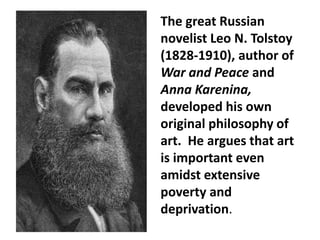This document provides an overview of the humanities and various aspects of art. It begins by describing a course that covers visual arts, performing arts, cinema, and literature, exposing students to classical and contemporary artists and works. It then discusses objectives like understanding the meaning and importance of art and appreciating different art forms. The document goes on to define the humanities and explain major areas like literature, visual arts, and performing arts. It also provides examples of famous works and discusses artistic styles, movements, and the subjects, forms, and values of art.











































































